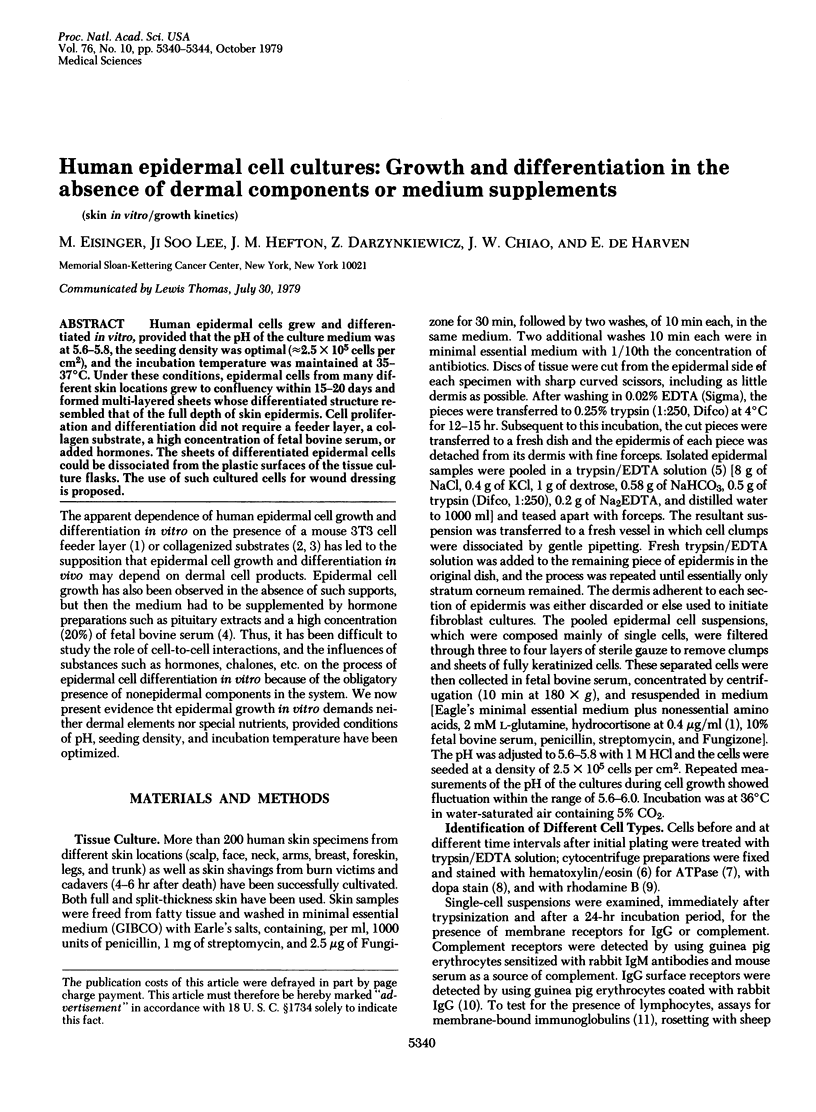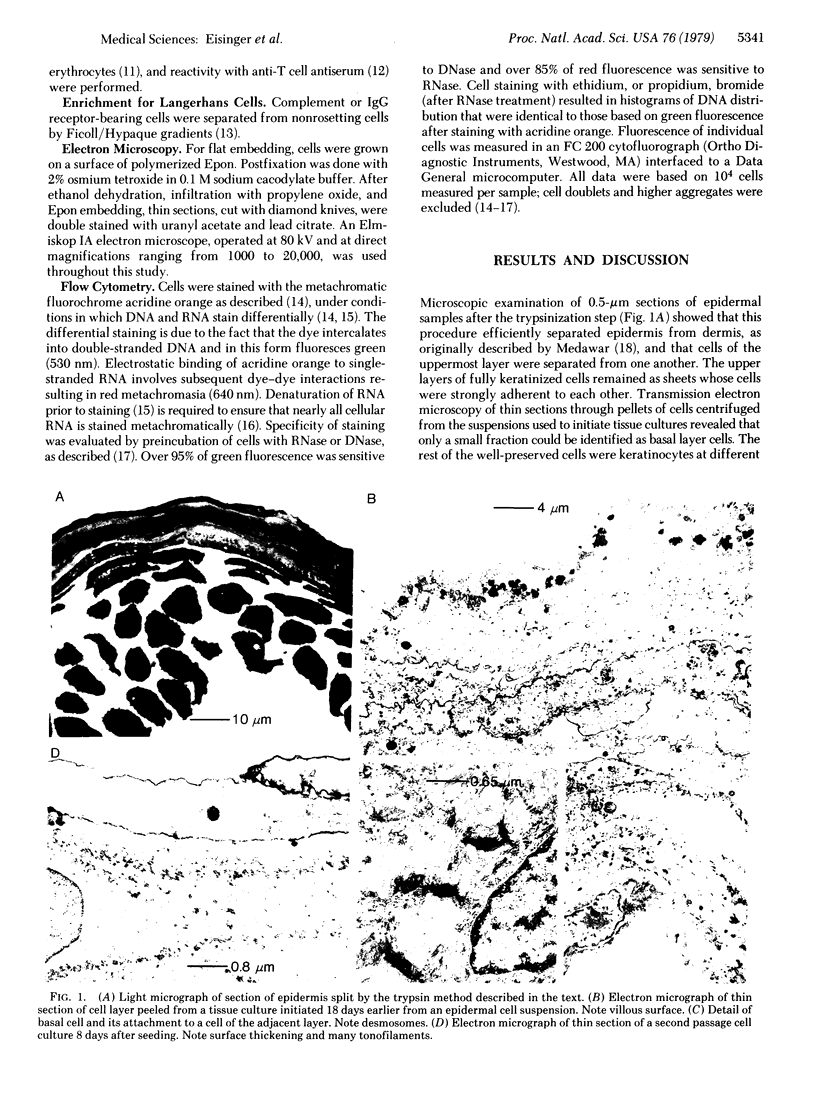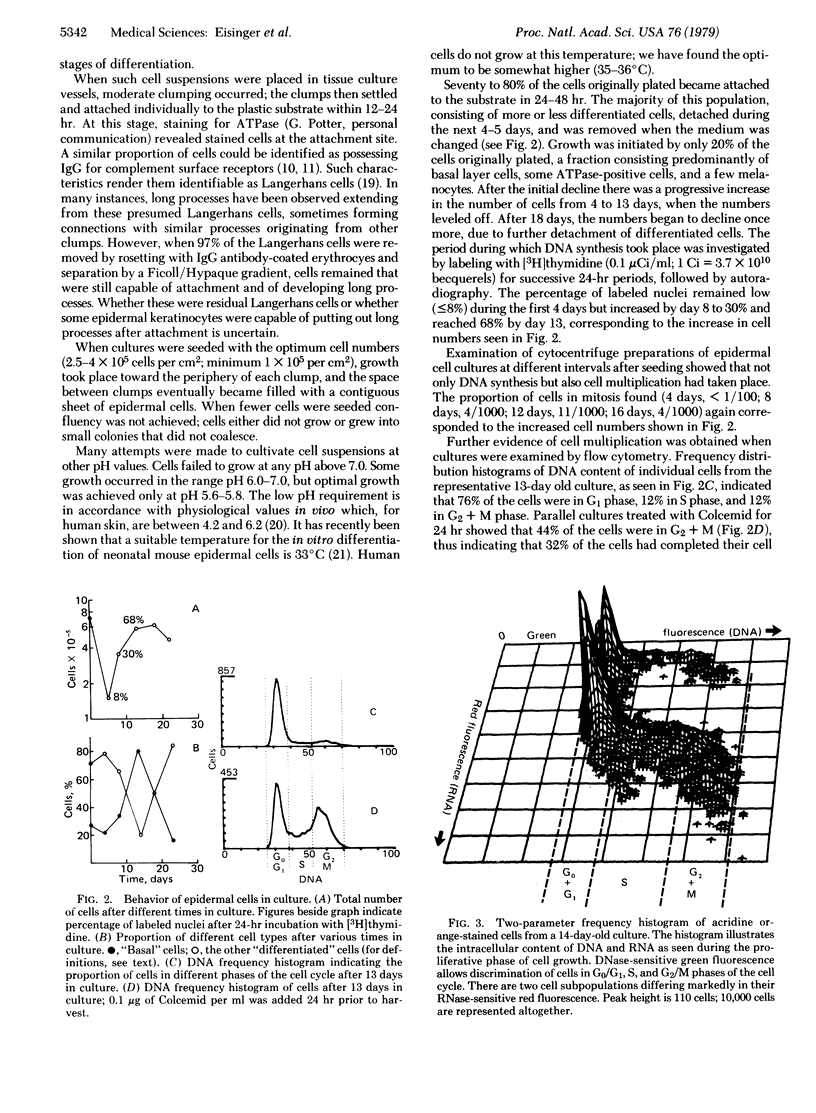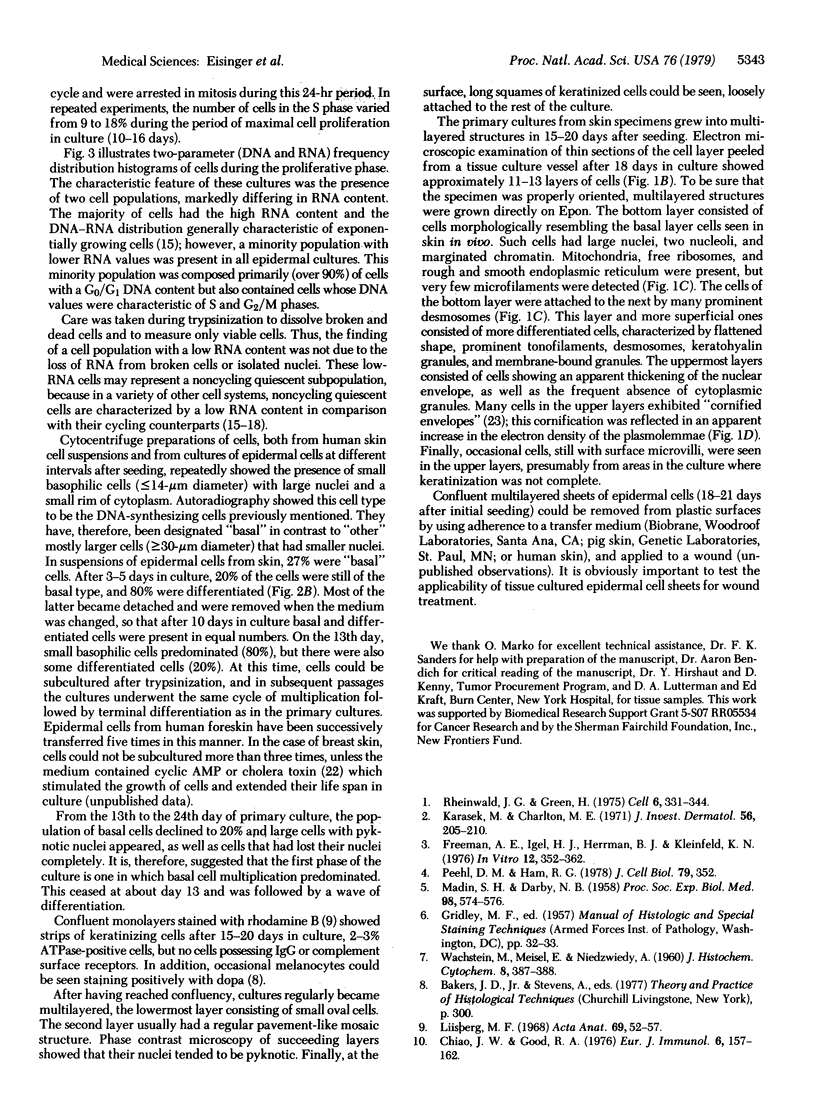Abstract
Human epidermal cells grew and differentiated in vitro, provided that the pH of the culture medium was at 5.6-5.8, the seeding density was optimal (approximately 2.5 x 10(5) cells per cm2), and the incubation temperature was maintained at 35-37 degrees C. Under these conditions, epidermal cells from many different skin locations grew to confluency within 15-20 days and formed multi-layered sheets whose differentiated structure resembled that of the full depth of skin epidermis. Cell proliferation and differentiation did not require a feeder layer, a collagen substrate, a high concentration of fetal bovine serum, or added hormones. The sheets of differentiated epidermal cells could be dissociated from the plastic surfaces of the tissue culture flasks. The use of such cultured cells for wound dressing is proposed.
Full text
PDF




Images in this article
Selected References
These references are in PubMed. This may not be the complete list of references from this article.
- Chiao J. W., Good R. A. Studies of the presence of membrane receptors for complement, IgG and the sheep erythrocyte rosetting capacity on the same human lymphocytes. Eur J Immunol. 1976 Mar;6(3):157–162. doi: 10.1002/eji.1830060304. [DOI] [PubMed] [Google Scholar]
- Chiao J. W., Pahwa R. N., Good R. A. Human T lymphocytes and myeloid colony forming cells share common antigen. Exp Hematol. 1980 Jan;8(1):6–15. [PubMed] [Google Scholar]
- Chiao J. W., Pantic V. S., Good R. A. Human lymphocytes bearing both receptors for complement components and SRBC. Clin Immunol Immunopathol. 1975 Nov;4(4):545–556. doi: 10.1016/0090-1229(75)90096-3. [DOI] [PubMed] [Google Scholar]
- Darzynkiewicz Z., Evenson D., Staiano-Coico L., Sharpless T., Melamed M. R. Relationship between RNA content and progression of lymphocytes through S phase of cell cycle. Proc Natl Acad Sci U S A. 1979 Jan;76(1):358–362. doi: 10.1073/pnas.76.1.358. [DOI] [PMC free article] [PubMed] [Google Scholar]
- Darzynkiewicz Z., Traganos F., Sharpless T. K., Melamed M. R. Cell cycle-related changes in nuclear chromatin of stimulated lymphocytes as measured by flow cytometry. Cancer Res. 1977 Dec;37(12):4635–4640. [PubMed] [Google Scholar]
- Darzynkiewicz Z., Traganos F., Sharpless T., Melamed M. R. Conformation of RNA in situ as studied by acridine orange staining and automated cytofluorometry. Exp Cell Res. 1975 Oct 1;95(1):143–153. doi: 10.1016/0014-4827(75)90619-9. [DOI] [PubMed] [Google Scholar]
- Darzynkiewicz Z., Traganos F., Sharpless T., Melamed M. R. Lymphocyte stimulation: a rapid multiparameter analysis. Proc Natl Acad Sci U S A. 1976 Aug;73(8):2881–2884. doi: 10.1073/pnas.73.8.2881. [DOI] [PMC free article] [PubMed] [Google Scholar]
- Freeman A. E., Igel H. J., Herrman B. J., Kleinfeld K. L. Growth and characterization of human skin epithelial cell cultures. In Vitro. 1976 May;12(5):352–362. doi: 10.1007/BF02796313. [DOI] [PubMed] [Google Scholar]
- Green H. Cyclic AMP in relation to proliferation of the epidermal cell: a new view. Cell. 1978 Nov;15(3):801–811. doi: 10.1016/0092-8674(78)90265-9. [DOI] [PubMed] [Google Scholar]
- Karasek M. A., Charlton M. E. Growth of postembryonic skin epithelial cells on collagen gels. J Invest Dermatol. 1971 Mar;56(3):205–210. doi: 10.1111/1523-1747.ep12260838. [DOI] [PubMed] [Google Scholar]
- Liisberg M. F. Rhodamine B as an extremely specific stain for cornification. Acta Anat (Basel) 1968;69(1):52–57. doi: 10.1159/000143063. [DOI] [PubMed] [Google Scholar]
- MADIN S. H., DARBY N. B., Jr Established kidney cell lines of normal adult bovine and ovine origin. Proc Soc Exp Biol Med. 1958 Jul;98(3):574–576. doi: 10.3181/00379727-98-24111. [DOI] [PubMed] [Google Scholar]
- Marcelo C. L., Kim Y. G., Kaine J. L., Voorhees J. J. Stratification, specialization, and proliferation of primary keratinocyte cultures. Evidence of a functioning in vitro epidermal cell system. J Cell Biol. 1978 Nov;79(2 Pt 1):356–370. doi: 10.1083/jcb.79.2.356. [DOI] [PMC free article] [PubMed] [Google Scholar]
- Rheinwald J. G., Green H. Serial cultivation of strains of human epidermal keratinocytes: the formation of keratinizing colonies from single cells. Cell. 1975 Nov;6(3):331–343. doi: 10.1016/s0092-8674(75)80001-8. [DOI] [PubMed] [Google Scholar]
- Shelley W. B., Juhlin L. The Langerhans cell: its origin, nature, and function. Acta Derm Venereol Suppl (Stockh) 1978;58(79):7–22. [PubMed] [Google Scholar]
- Stingl G., Katz S. I., Clement L., Green I., Shevach E. M. Immunologic functions of Ia-bearing epidermal Langerhans cells. J Immunol. 1978 Nov;121(5):2005–2013. [PubMed] [Google Scholar]
- Sun T. T., Green H. Differentiation of the epidermal keratinocyte in cell culture: formation of the cornified envelope. Cell. 1976 Dec;9(4 Pt 1):511–521. doi: 10.1016/0092-8674(76)90033-7. [DOI] [PubMed] [Google Scholar]
- WACHSTEIN M., MEISEL E., NIEDZWIEDZ A. Histochemical demonstration of mitochondrial adenosine triphosphatase with the lead-adenosine triphosphate technique. J Histochem Cytochem. 1960 Sep;8:387–388. doi: 10.1177/8.5.387. [DOI] [PubMed] [Google Scholar]



